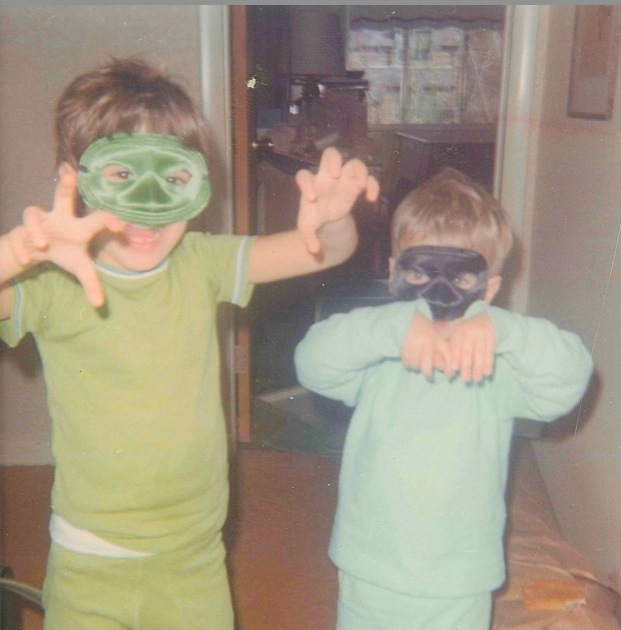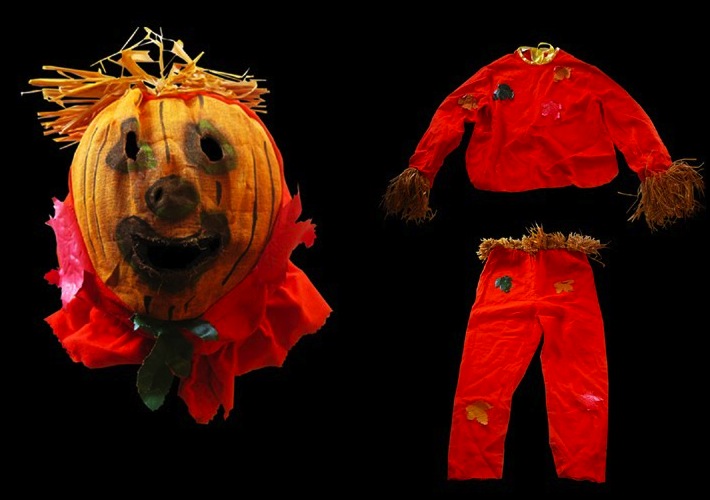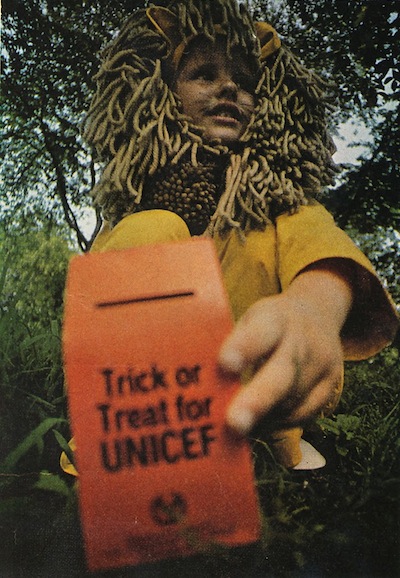The author (left) in a bad boy’s haircut and little brother
The ritual is familiar to almost anyone who grew up in America in the late twentieth century. Halloween has become perhaps the most “universal” American holiday. It proposes no ethnic identity, no national allegiance, no specific religious affiliations. You don a costume and walk around your neighborhood asking for candy. Growing up in Philadelphia, Halloween was a very big deal. Halloween was the gateway to the Holiday Season. Beyond that lay the post holidays descent into the revolting slush and bitter cold and the accompanying depression. Life began at Halloween and ended December 26th.
I’m from the last generation of people who went trick or treating in the glory days of shelling out – the 1970’s. There were no school shootings, no peanut allergies or gluten intolerances, no kid obesity epidemic. There weren’t many modern sensitivities at all. Costumes I remember making were pirate, hobo (just a jolly cartoon character who chooses to carry a stick with a bandana tied to it, jumpin’ trains and cookin’ hobo beans over a campfire), Indian chief and the devil, many things that would be considered insensitive today. There was no “global warming”, so it was a good ten degrees colder, and we often had the indignity of having to wear parkas over our costumes.
Halloween is beloved/ruined for 3 very simple reasons:
1. Adults have co-opted it, as it it offers them the opportunity to act like morons, often wildly, inexcusably drunk on work nights, while cloaked in the guise of cocktail-ready costumes like Don Draper or Lucy.
2. It is open season for repressed ladeez to dress like hobags and for Straight Men to cross dress.
3. Parents have the desire – or guilt – to have their children perform the Halloween rituals, but not the willingness or imagination to do the work. They quickly perform the manic exercise of throwing on prepared costumes, driving them to some neighborhood somewhere and ushering their little Disney thing or Marvel thing through ADH-paced candy grabs. Isn’t the whole point of bringing up children to raise them to be better than yourself in all aspects? Why do well-meaning parents systematically ignore or minimize the very traditions they themselves enjoyed as kids?
CANDY
Candy seemed very precious, something we had access to on candy heavy holidays like Halloween, Christmas Valentines Day and Easter. Most children today (even poor children), have access to candy. It may be only one day, but Halloween is emblematic of lives of excess. Why do kids today need a special Day of Candy when they have lives of candy?
TRICKS
Margaret Mead lamented in a 1975 Redbook article: “Halloween is all treats and no tricks. There’s no mischief at all”. The ritual observance of Halloween by trick-or-treating seems nothing more than a rehearsal for consumership without a rationale. It never occurs to children today that there is any threat or even suggestion of a “trick”. We said “trick-or-treat,” but everyone knew it meant “I’m here to get a treat”? My best friend Stephanie’s mom categorically insisted we do a “trick” to receive our treat. It added a bit of suspense and anticipation, not just expecting “the goods”. The modern child has to do nothing to get what he wants.
The author and brother, carrying on the nerdy traditions well into our teens.
RITUALS

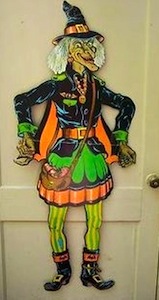
For me, it always comes down to rituals. The lack of rituals and traditions perpetrated by preoccupied parents will be the death of the future generations. Besides the traditional night of carving the pumpkin, every year we hauled out the standard brand, paper jointed witch and skeleton. We must have used the same decorations for 20 years. Every year after Halloween they were carefully packed away. The crepe paper table cloth was unsuccessfully stuffed back into the plastic wrapper for another year. Goods back then were not disposable. They were crappy treasures that we looked forward to unpacking year after year.

Our mom (a doctor not a homemaker), would manager to dress up in a homemade witch costume made of scratchy black burlap and hand out candy – which she had divvied up in special goody bags and laid out in baking tins.
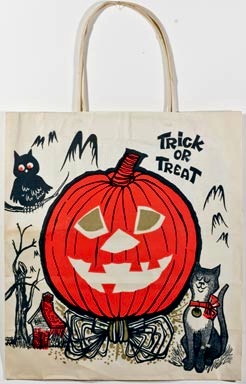
Nothing is perhaps more emblematic of Halloween’s decline than the Hefty fckng garbage bags. Cocky son-of-a-bitches dragging garbage bags down the street. We had reusable printed trick or treat bags. Although we wanted a lot of candy, that was really not the apex of the Halloween thrill. It wasn’t the desperate, timed candy grabt is today. I wonder, is the spectacle of middle-class children descending into beggary just a little bit appalling to parents? How can you let your kid actually drag a freaking Hefty garbage bag out on Halloween????
COSTUMES
After the preschool age of our mom buying our costumes from FAO Schwarz lapsed, we always made our costumes, it was what one did. There was no looking through catalogs, picking out a costume with all the accessories to be drone- dropped at your door. You didn’t see gals in store-bought Hannah Montana costumes carrying“trick-or-treat” bags from WalMart, miniature mass consumers in training for future adult consumption. Nobody had store-bought costumes expect for those poor kids whose parents bought them those cheap (but weirdly desirable) boxed costumes with the hard masks at Woolworth’s.
This was an actual store-bought costume my mother actually bought and my brother actually wore
My future-engineer brother challenged his ADD and carefully and patiently executed his “robot” costume utilizing his ingenuity, a microwave box and Reynolds Wrap. My future-production-designer sister spent months constructing a beautiful and elaborate pair of flapping butterfly wings. Planning and making our costumes could months, and was an exercise in ownership, creativity and patience. Fourth-graders would spend three months making a jellyfish costume, just to wear it for one night! To the parents of of the franchise costumed kids, you are doing your children a disservice. What about the embarrassing trips to JoAnn’s Fabrics? What about the costume sketching in school books during class? Without the requisite traditions and effort – by picking a sweatshop pre-made costume online – trick-or-treating constitutes a passive consumption, devoid of creativity or authentic activity, emerging out of a hodgepodge of extant festive practices and a dose of pop-culture imagination.
NEIGHBORHOOD
When I was a kid, your neighborhood played a pivotal role in the tradition of Halloween. What I see today is an entirely novel element of unneighborliness, driving to random neighborhoods, sometimes by bus, detaching into tight little groups in strange neighborhoods in a variation of ritualized begging, knocking at midnight on strangers doors, sometimes two-timing, and traversing miles and miles of the suburbs. We were expected to behave orderly and above all, be neighborly. We were not allowed to pass up the spooky elderly, childless couple who insisted on us coming into the house and having a cup of cider. We certainly did not stray outside of our neighborhood going to strangers house , that would have been gauche. Sure there were neighborhoods where candy opportunities were heightened. Richer people, bigger houses, more opportunities for FULL SIZED candy bars. But that, Charlie Brown, was not what Halloween was all about.
THE DO-GOODS
In 1947, children from 14 schools participated in passing up candy in favor of collecting food for the needy overseas. The children were instructed to say: “No tricks, just a treat, for starving children who want to eat.” In 1956 the American Service Friends Committee sent 200,000 children on trick-or-treating rounds as “friendly beggars” with specially printed “shopping bags” to collect children’s clothing, school supplies, and sewing materials for overseas distribution. In my era, we agreed to supplement our candy begging and apply our Halloween efforts for others via trick-or-treat for UNICEF.
At my progressive elementary school, we were given neat little orange boxes. It was exciting. The collecting of coins for UNICEF did not preclude a tour of the neighborhood for candy. We brought a treat bag and a UNICEF box along on our appointed rounds. But we were suddenly doing something for kids in the Third World, and it was intoxicating and disruptive. I could literally feel the weight of my fundraising efforts as I shlepped around the neighborhood, the feeling of the little orange box growing heavier with with each nickel and dime. The next day we’d return our boxes to school and have the teacher compliment our efforts.
DANGER
Lastly, Philadelphia in the 1970’s was a sad and scary place! We were ground zero to the Halloween Sadism terrorizing the country: Poison laced candy, heroin pumped into candy bars through the wrapper with hyper dermic needles….The myth of the Halloween Sadism has since been debunked, but back then it was full steam ahead. Maniacs were injecting Almond Joys with rat poison and shoving razor blades into candy apples. Granted, no one in their right mind would touch a candy apple in the first place— that hard plasticized shellac on a piece of fruit being so much lipstick on a pig. But we knew death was possible. Halloween was terrifying and thrilling with a whiff of homicide.
The moral of the story is, everything was better then and everything sucks now because even though parents are more enlightened, they are all shallow, mindless consumers with ADD.
END
